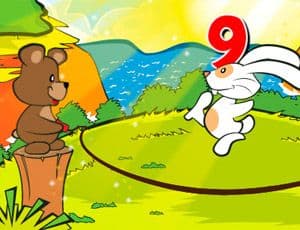Escola Games | Jogos Educativos
https://www.escolagames.com.br
Teacher's support sheet

Learning to Count
What do you think about jumping rope with a bunny and learning to count to 100 in different languages?
Choose your language (Portuguese, English, Spanish, or Italian) and click on the bunny. It will start jumping and counting!

Teacher's tips
Level of Education: Preschool - Elementary School
Theme: numbers and operations
Age: 5 to 12 years old
Counting is a form to understand how the numeric system is structured and systematized. Learning to count helps students with counting in different languages. [FIM-DICA]
Learner outcomes
Say and memorize the numerical system from 1 to 100;
To develop logical thinking and understand the concept of 'number' playfully;
To recognize the names of the numbers and how they are represented;
To systematize ways of registering quantities;
To stimulate logical thinking;
To use the game as a path to problem-solving;
To learn the numbers in other languages;
To comprehend other languages.
Teachers' goals
To stimulate counting;
To offer the game as a didactic audiovisual resource that stimulates learning and systematizing numerical sequences;
To work with the numerical sequence from 1 to 100;
To encourage students to learn other languages;
To reinforce content discussed in class;
To highlight the regularity of changes starting from the number 9.
Suggestions of approaches for the teacher
(Approach 1) Students can play the games individually or in groups. Tell students to play and observe the numbers on the screen and pay attention to the audio.
(Approach2) Challenge your students! For younger children, ask: “Which number comes after 17?" They must be attentive not to get lost in the numerical sequence.
(Approach 3) For older students, prepare a table with blanks and ask them to fill in the correct numbers. They will have to analyze predecessors and successors to do the activity.
(Approach 4) Kids usually struggle to memorize the change between tens (29/30, 39/40). To help, you can prepare a numerical chart with the numbers representing these passages and ask students to fill in the blanks.
(Approach 5) Encourage students to count their objects and write that in their notebooks. Ask them to count in different languages. They can count using one language at a time.
(Approach 6) Ask students to research words of a language that speakers use in other languages. An example is to look for Italian terms that people use when they speak English.
(Approach 7) Hopscotch from 0 to 10. Ask students to count in ascending and descending order while they are jumping.
(Approach 8) Together with the maths teacher, organize an activity in which students have to solve operations in a different language.
(Approach 9) Encourage students to look at dictionary words from their daily lives in other languages.
(Approach 10) Ask students to look for a song in another language and share it with their classmates.
More about the content
The teacher must stimulate the students' oral comprehension first and show them the relation between words and their written form when teaching an additional language. You can practice it with the numbers, reinforcing the pronunciation of the phonemes. The teacher must pay attention to students' pronunciation to confirm they are pronouncing it correctly. Only after that, the teacher should present the students with the written forms of the numbers, assuring that they follow the numerical sequence.
You can enrich the project with different oral activities that involve music, poems, and other things so that they practice their speaking skills.
